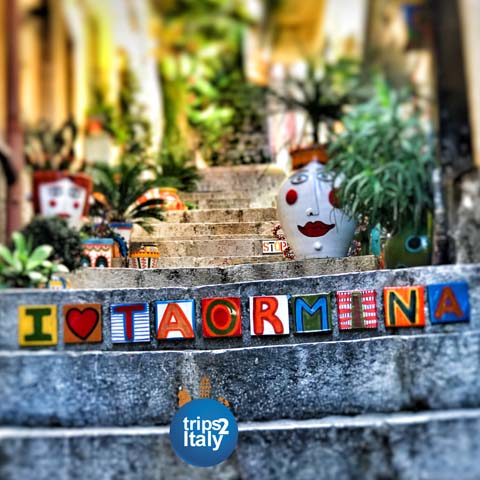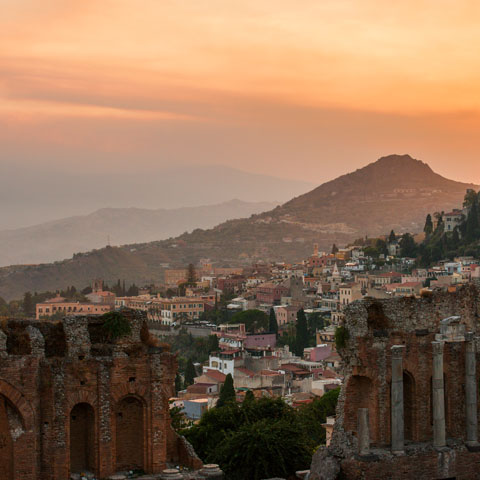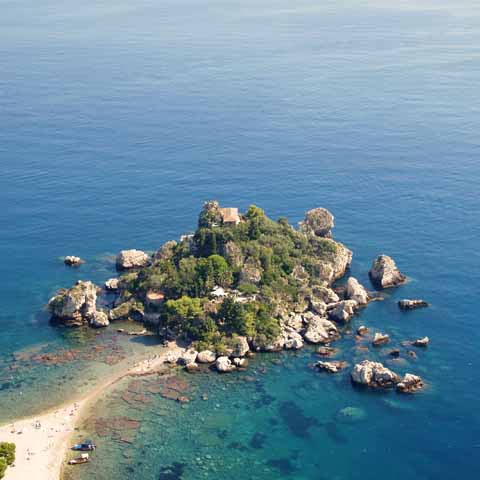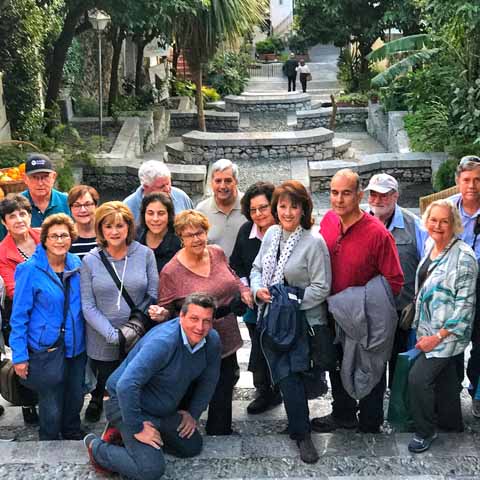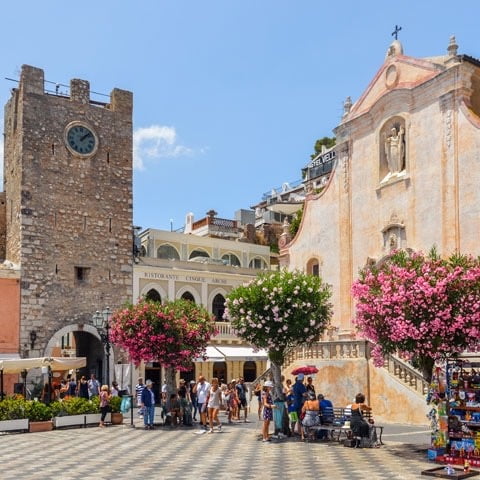One of Sicily’s most beautiful and historic towns, Taormina is known for its seaside views, ancient monuments, and incredible culture. Since the early twentieth century, the city was known to be a gathering place for artists, writers, and scholars of all kinds.
The city’s vast history offers travelers the opportunity to explore unique archaeology, architecture, and art. In addition to a history filled with culture, modern-day Taormina is still bursting with culture at every turn. From boutique shops to bustling restaurants and bars to lively artistic festivals, travelers will love the abundance of cultural offerings in Taormina.
ART
The city of Taormina itself can be described as a living, breathing work of art. The views of Mt. Etna, the sparkling sea, and the ancient buildings and monuments make it a picture-perfect destination to visit.
In addition to its natural beauty, travelers can experience art in Taormina at various palaces and churches throughout the city. Taormina’s Palace of the Dukes of Santo Stefano is a wonderful example of Arab-Norman art and contains sculptures that belong to the Mazzullo Foundation.
Although it is also an architectural monument, Taormina’s famous Greek theater is a testament to the city’s incredible artistic value. The ancient theater, which is the second largest in Sicily, serves as a historic monument as well as the home of many artistic events in the city. Taormina Arte, the city’s main cultural institution, organizes a number of cultural events at the Greek theater and in other venues where music, theater, opera, and other performances are showcased.
German artist Otto Geleng helped Taormina become a popular travel destination after he created paintings of the city’s many amazing offerings – landscapes of mountains, images of the sprawling sea, and picturesque ancient ruins. When his work was on display in other parts of Europe, he was accused of “imagining” such a beautiful locale and that beauty such as that could not actually exist. He urged critics of his work to visit Taormina and see for themselves. Those who did where not disappointed by what they found.
A famous painter who lived in Taormina was British watercolorist Robert Hawthorn Kitson. He called the city home during the late 1800s to early 1900s.
ARCHITECTURE
As one of Sicily’s most historic towns, there is an abundance of architecture and archeological ruins to explore in Taormina. Like the rest of Sicily, the architectural influences throughout the city run the gamut, as the region is historically one of Italy’s most multicultural locations.
The city’s cathedral, the Duomo di Taormina, is a spectacular Renaissance-style structure. It was built in the thirteenth century and remodeled in the fifteenth, sixteenth, and eighteenth centuries, giving it a multigenerational look. Because of these many renovations, it features a variety of architectural elements, including portals and windows that have varying artistic inspiration. Inside, it houses paintings by Antonino Giuffre and an altarpiece by Antonello de Saliba. Outside the Duomo is a beautiful Baroque fountain that dates back to the seventeenth century.
Other churches throughout the city that are worth visiting for their architecture include the Church of San Pancrazio, the Church of St. Catherine of Alexandria, and the Church of St. Joseph – all of which are heavily Baroque-styled.
Another unique architectural locale to visit is the Roman Odeon Theater. This much smaller version of an outdoor theater is said to have been built in 21 BC by the first Roman empire. It was once used as a gathering place for civic events as well as musical and literary performances, but now serves as a testament to Taormina’s vast history.
One of Taormina’s most striking palaces is Palazzo Corvaja, which was built on the site of the Ancient Roman Forum. The current structure dates back to the fourteenth century and features four main floors with a courtyard. The exterior is decorated with Gothic elements and it also features a Norman tower. After being owned by one of Taormina’s most famous families from the sixteenth to the twentieth century, the Corvaja family, today the palace hosts many of the city’s exhibitions.
Porta Messina is one of two surviving city gates in Taormina. The gate was inaugurated in 1808 by Ferdinand IV of Bourbon, and for this reason it is also called Porta Ferdinandea.
LITERATURE
Taormina was documented by famed German poet Johann Wolfgang Goethe in his book Italian Journey. He dedicated a portion of the book to Taormina and brought attention to the city as a cultural destination.
It was also honored in literary work via D.H. Lawrence’s short stories, poems, novels, and more.
Other writers who were inspired by Taormina include Alexandre Dumas, Oscar Wilde, Guy de Maupassant, Truman Capote, Charles Webster Leadbeater, Halldor Laxness, Daphne Phelps, and more.
MUSIC
Taormina is a city that embraces and celebrates music, primarily during its summer music events and festivals. The city’s Greek Theater is a venue for concerts of all genres, including orchestral, pop, opera, and more.
The city has served as the birthplace and inspiration for musicians, including guitarist Francesco Buzzurro and composer and actress Carla Cassola. Songwriter Mark Knopfler also wrote about Taormina in Lights of Taormina, a song from his 2015 album.
SCIENCE
Taormina is considered to be one of the world’s most important archaeological sites since the Greeks’ first colony ever settled in Italy (Naxos) is located there. The ancient ruins and monuments that are located throughout Taormina, such as the famed Greek Theater, ancient churches, spectacular palaces, and more all contribute to the city’s status as an excellent archaeological destination.
FILM
Taormina Arte organizes one of the most important film festivals in Italy – the Taormina Film Fest. Dating back to 1955, the film festival celebrates the best of cinema by screening films and presenting filmmakers with awards by Italian Film Journalists.
The setting of Taormina is stunning and worth being captured on the big screen. One notable example is French film The Big Blue, which was partly filmed in Taormina.
Other movies filmed in Taormina include: The Light Touch (1951), L’arte di arrangiarsi (1954), L’avventura (1960), Il piccolo diavolo (1988), The Godfather: Part III (1990), Johnny Stecchino (1991), Mighty Aphrodite (1995), and Grande, grosso e… Verdone (2008).
The legendary beauty of Taormina is said to enchant all who visit. In addition to the natural panoramas, travelers will also enjoy the town’s rich cultural life, which includes ancient monuments, historic art, and striking architecture.
Don't just see Italy, live it.
Your dream trip to Italy has never been closer
No more endlessly scrolling travel sites. Our travel experts will craft the perfect, one-of-a-kind trip just for you.

300+
DESTINATIONS
We offer more Italian destinations than any travel site. Do and see more with Trips 2 Italy.
1 (of a kind)
ITINERARIES
Because your dream trip to Italy should be designed for you, not for the masses.
100%
PEACE OF MIND
From flights and accommodations, to food and activities - we take care of every detail.
